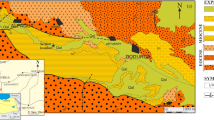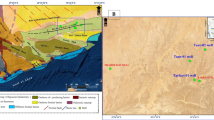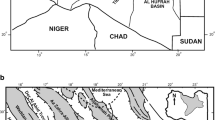Abstract
Fatty acids were extracted from fluid inclusions, and analyzed for distribution and individual δ13C values to determine if there exists sulfate-reducing bacteria (SRB) and what substrates SRB depleted during U mineralization in the Dongsheng deposit. The 10-methylhexadecanoic acid (10Me16:0) has been detected from most of the samples using GC-MS based on relative retention time and co-injection of standard 10Me16:0 compound. Samples with higher 10Me16:0 concentrations, show higher U contents. The presence of 10Me16:0 along with iso-ω7-cis-heptadecenoic acid (i17:1ω7c) and ω7-cis-octadecenoic acid (18:1ω7c) in the fluid inclusions may indicate the occurrence of SRB during the U mineralization. Saturated fatty-acids and unsaturated fatty-acids detected in this study have individual δ13C values from -30.3‰ to -28.5‰ and -30.5‰ to -27.9‰, respectively. These values are close to those of n-alkanes of the associated oils and the bulk oils, but significantly distinct from methane, thus the oils are concluded to have been used as substrate for the microorganisms to survive on. This proposal is supported by oil biodegradation and ore-stage calcite cement with δ13C values from -1.4‰ to -17.2‰.
Similar content being viewed by others
References Cited
Abdelouas, A., Lutze, W., Gong, W. L., et al., 2000. Biological Reduction of Uranium in Groundwater and Subsurface Soil. Science of The Total Environment, 250(1/2/3): 21–35. https://doi.org/10.1016/s0048-9697(99)00549-5
Aharon, P., Fu, B. S., 2000. Microbial Sulfate Reduction Rates and Sulfur and Oxygen Isotope Fractionations at Oil and Gas Seeps in Deepwater Gulf of Mexico. Geochimica et Cosmochimica Acta, 64(2): 233–246. https://doi.org/10.1016/s0016-7037(99)00292-6
Apon, J. M. B., Nicolaides, N., 1975. The Determination of the Position Isomers of the Methyl Branched Fatty Acid Methyl Esters by Capillary GC/MS. Journal of Chromatographic Science, 13(10): 467–473. https://doi.org/10.1093/chromsci/13.10.467
Arning, E. T., Birgel, D., Schulz-Vogt, H. N., et al., 2008. Lipid Biomarker Patterns of Phosphogenic Sediments from Upwelling Regions. Geomicrobiology Journal, 25(2): 69–82. https://doi.org/10.1080/01490450801934854
Beech, I. B., Cheung, W. S., 1995. Interactions of Exopolymers Produced by Sulphate-Reducing Bacteria with Metal Ions. International Biodeterioration & Biodegradation, 35(1/2/3): 330. https://doi.org/10.1016/0964-8305(95)90028-4
Brookins, D. G., 1976. Position of Uraninite and/or Coffinite Accumulations to the Hematite-Pyrite Interface in Sandstone-Type Deposits. Economic Geology, 71(5): 944–948. https://doi.org/10.2113/gsecongeo.71.5.944
Cai, C. F., Dong, H. L., Li, H. T., et al., 2007a. Mineralogical and Geochemical Evidence for Coupled Bacterial Uranium Mineralization and Hydrocarbon Oxidation in the Shashagetai Deposit, NW China. Chemical Geology, 236(1/2): 167–179. https://doi.org/10.1016/j.chemgeo.2006.09.007
Cai, C. F., Li, H. T., Qin, M. K., et al., 2007b. Biogenic and Petroleum-Related Ore-Forming Processes in Dongsheng Uranium Deposit, NW China. Ore Geology Reviews, 32(1/2): 262–274. https://doi.org/10.1016/j.oregeorev.2006.05.003
Cai, C. F., Li, H. T., Luo, X. R., 2005. Petroleum-Related Origin for Sandstone-Hosted Uranium Deposits in the Dongsheng Area, Ordos Basin (China). In: Mao, J. W., Bierlein, F. P., eds., Mineral Deposit Research: Meeting the Global Challenge. Springer, Berlin, Heidelberg. 229–232
Canfield, D. E., Farquhar, J., Zerkle, A. L., 2010. High Isotope Fractionations during Sulfate Reduction in a Low-Sulfate Euxinic Ocean Analog. Geology, 38(5): 415–418. https://doi.org/10.1130/g30723.1
Dowling, N. J. E., Widdel, F., White, D. C., 1986. Phospholipid Ester-Linked Fatty Acid Biomarkers of Acetate-Oxidizing Sulphate-Reducers and other Sulphide-Forming Bacteria. Microbiology, 132(7): 1815–1825. https://doi.org/10.1099/00221287-132-7-1815
Duan, Y., Song, J. M., Zhang, H., 2004. Carbon Isotopic Studies of Individual Lipids in Organisms from the Nansha Sea Area, China. Science in China Series D: Earth Sciences, 47(7): 593–598. https://doi.org/10.1360/03yd0561
Duan, Y., Luo, B. J., Qian, J. S., et al., 1996. Study on Organic Geochemistry of Fatty Acids in Recent Sediments from Nansha Sea Area. Marine Geology & Quaternary Geology, 16: 23–31 (in Chinese with English Abstract)
Duan, Y., Ma, L. H., 1996. Several Problems Concerned with Stable Carbon Isotopic Geochemistry of Biomarker Compounds. Advance in Earth Sciences, 11: 31–36 (in Chinese with English Abstract)
Duan, Y., Wen, Q. B., Luo, B. J., 1995. Carbon Isotopic Compositions and Origin of Individual Fatty Acids in Modern Sediments. Geochimica, 24: 270–275 (in Chinese with English Abstract)
Duan, Y., Wen, Q. B., Zheng, G. D., et al., 1997. Isotopic Composition and Probable Origin of Individual Fatty Acids in Modern Sediments from Ruoergai Marsh and Nansha Sea, China. Organic Geochemistry, 27(7/8): 583–589. https://doi.org/10.1016/s0146-6380(97)00072-7
Elvert, M., Boetius, A., Knittel, K., et al., 2003. Characterization of Specific Membrane Fatty Acids as Chemotaxonomic Markers for Sulfate-Reducing Bacteria Involved in Anaerobic Oxidation of Methane. Geomicrobiology Journal, 20(4): 403–419. https://doi.org/10.1080/01490450303894
George, S. C., Ahmed, M., Liu, K. Y., et al., 2004. The Analysis of Oil Trapped during Secondary Migration. Organic Geochemistry, 35(11/12): 1489–1511. https://doi.org/10.1016/j.orggeochem.2004.07.007
Habicht, K. S., Canfield, D. E., 1997. Sulfur Isotope Fractionation during Bacterial Sulfate Reduction in Organic-Rich Sediments. Geochimica et Cosmochimica Acta, 61(24): 5351–5361. https://doi.org/10.1016/s0016-7037(97)00311-6
Jiang, L., Cai, C. F., Zhang, Y. D., et al., 2012. Lipids of Sulfate-Reducing Bacteria and Sulfur-Oxidizing Bacteria Found in the Dongsheng Uranium Deposit. Chinese Science Bulletin, 57(11): 1311–1319. https://doi.org/10.1007/s11434-011-4955-4
Kumar, R., Nongkhlaw, M., Acharya, C., et al., 2013a. Uranium (U)-Tolerant Bacterial Diversity from U Ore Deposit of Domiasiat in North-East India and Its Prospective Utilisation in Bioremediation. Microbes and Environments, 28(1): 33–41. https://doi.org/10.1264/jsme2.me12074
Kumar, R., Nongkhlaw, M., Acharya, C., et al., 2013b. Growth Media Composition and Heavy Metal Tolerance Behaviour of Bacteria Characterized from the Sub-surface Soil of Uranium Rich Ore Bearing Site of Domiasiat in Meghalaya. Indian Journal of Biotechnology, 12: 115–119
Liu, Y. Q., Feng, Q., Yang, R. C., et al., 2006. Discussion on Genesis of Sandstone-Type Uranium Deposits in Dongsheng Area, Ordos Basin. Acta Petrologica Sinica, 80: 761–767 (in Chinese with English Abstract)
Londry, K. L., Jahnke, L. L., Des Marais, D. J., 2004. Stable Carbon Isotope Ratios of Lipid Biomarkers of Sulfate-Reducing Bacteria. Applied and Environmental Microbiology, 70(2): 745–751. https://doi.org/10.1128/aem.70.2.745-751.2004
Lovley, D. R., Phillips, E. J. P., Gorby, Y. A., et al., 1991. Microbial Reduction of Uranium. Nature, 350(6317): 413–416. https://doi.org/10.1038/350413a0
Lovley, D. R., Phillips, E., 1992. Reduction of Uranium by Desulfovibrio Desulfuricans. Applied and Environmental Microbiology, 58: 850–856
Magnuson, K., Jackowski, S., Rock, C., et al., 1993. Regulation of Fatty Acid Biosynthesis in Escherichia Coli. Microbiological Reviews, 57: 522–542
Milodowski, A. E., West, J. M., Pearce, J. M., et al., 1990. Uranium-Mineralized Micro-Organisms Associated with Uraniferous Hydrocarbons in Southwest Scotland. Nature, 347(6292): 465–467. https://doi.org/10.1038/347465a0
Min, M. Z., Peng, X. J., Wang, J. P., et al., 2003a. Progress in Study onMicrobe-Metallogenesis of Uranium. Uranium Geology, 19: 257–263 (in Chinese with English Abstract)
Min, M. Z., Wang, R. C., Bian, L. Z., et al., 2003b. Microbe-Metallogenesis of Interlayer Oxidized Zone Type Sandstone Uranium Deposit. Acta Petrologica Sinica, 13: 54–58 (in Chinese with English Abstract)
Min, M. Z., Xu, H. F., Chen, J., et al., 2005. Evidence of Uranium Biomineralization in Sandstone-Hosted Roll-Front Uranium Deposits, Northwestern China. Ore Geology Reviews, 26(3/4): 198–206. https://doi.org/10.1016/j.oregeorev.2004.10.003
Panak, P., Raff, J., Selenska-Pobell, S., et al., 2000. Complex Formation of U(VI) with Bacillus-Isolates from a Uranium Mining Waste Pile. Radiochimica Acta, 88(2): 71. https://doi.org/10.1524/ract.2000.88.2.071
Peters, K. E., Moldowan, J. M. 1993. The Biomarker Guide: Interpreting Molecular Fossils in Petroleum and Ancient Sediments. Prentice Hall Englewood Cliffs, NJ
Ramsing, N. B., Kühl, M., Jørgensen, B. B., 1993. Distribution of Sulfate-Reducing Bacteria, O2, and H2S in Photosynthetic Biofilms Determined by Oligonucleotide Probes and Microelectrodes. Applied and Environmental Microbiology, 59: 3840–3849
Strauss, H., 1997. The Isotopic Composition of Sedimentary Sulfur through Time. Palaeogeography, Palaeoclimatology, Palaeoecology, 132(1/2/3/4): 97–118. https://doi.org/10.1016/s0031-0182(97)00067-9
Tuo, J. C., Ma, W. Y., Zhang, M. F., et al., 2007. Organic Geochemistry of the Dongsheng Sedimentary Uranium Ore Deposits, China. Applied Geochemistry, 22(9): 1949–1969. https://doi.org/10.1016/j.apgeochem.2007.03.060
Tuo, J. C., Zhang, M. F., Wang, X. B., 2006. The Content and Significance of Fatty Acid Methylesters in Dongsheng Sedimentary Uranium Ore Deposits Ordos Basin China. Acta Sedimentologica Sinica, 24: 432–439 (in Chinese with English Abstract)
Wakeham, S. G., 1995. Lipid Biomarkers for Heterotrophic Alteration of Suspended Particulate Organic Matter in Oxygenated and Anoxic Water Columns of the Ocean. Deep Sea Research Part I: Oceanographic Research Papers, 42(10): 1749–1771. https://doi.org/10.1016/0967-0637(95)00074-g
Wakeham, S. G., Amann, R., Freeman, K. H., et al., 2007. Microbial Ecology of the Stratified Water Column of the Black Sea as Revealed by a Comprehensive Biomarker Study. Organic Geochemistry, 38(12): 2070–2097. https://doi.org/10.1016/j.orggeochem.2007.08.003
Wang, M., Luo, J. L., Li, M., et al., 2013. Provenance and Tectonic Setting of Sandstone-Type Uranium Deposit in Dongsheng Area, Ordos Basin: Evidence from U-Pb Age and Hf Isotopes of Detrital Zircons. Acta Petrologica Sinica, 29: 2746–2758 (in Chinese with English Abstract)
White, C., Shaman, A. K., Gadd, G. M., 1998. An Integrated Microbial Process for the Bioremediation of Soil Contaminated with Toxic Metals. Nature Biotechnology, 16(6): 572–575. https://doi.org/10.1038/nbt0698-572
Wu, B. L., Qiu, X. W., 2007. Geological and Geochemical Characteristics of Escaped Hydrocarbon Epigenetic Alteration in the Dongsheng Mineral Deposit and Its Significance. Geology in China, 34: 455–462 (in Chinese with English Abstract)
Yin, J. S., Xiang, W. D., Ou, G. X., et al., 2005. Sandstone-Type Uranium Mineralization with Respect to Organic Matter, Microbe, and Oil and Gas. Uranium Geology, 21: 287–295 (in Chinese with English Abstract)
Zeng, A. H., Pan, J. Y., 2013. Geochemical Feature of Stable Isotopes in Sandstone-Type Uranium Deposit 511 in Xinjiang, China. Uranium Geology, 29: 72–77 (in Chinese with English Abstract)
Zhang, C. L., Huang, Z., Cantu, J., et al., 2005. Lipid Biomarkers and Carbon Isotope Signatures of a Microbial (Beggiatoa) Mat Associated with Gas Hydrates in the Gulf of Mexico. Applied and Environmental Microbiology, 71(4): 2106–2112. https://doi.org/10.1128/aem.71.4.2106-2112.2005
Zhang, W. Z., Li, J. F., 2001. Oil and Gas Source Research of Ordos Basin. Petroleum Geology & Experiment, 6: 28–36 (in Chinese with English Abstract)
Zhang, Y. D., Su, Y. L., Liu, Z. W., et al., 2014. Long-Chain Branched/Cyclic Alkanes in Recent Sediment of Lake Fuxian and Their Environmental Implications. Chinese Science Bulletin, 59(11): 1139–1150. https://doi.org/10.1007/s11434-014-0159-z
Zhao, R. Q., Qin, M. K., Wang, Z. B., 1998. Effect of Microorganism and Organic Matters on Sandstone Type Uranium Mineralizations in Interlayer Oxidation Zone in Deposit No. 512. Uranium Geology, 14: 338–343, 379 (in Chinese with English Abstract)
Zhu, X. Y., Peng, X. J., Wang, Y. L., et al., 2004. Isotope Geochemistry of Shihongtan Interlayer Oxidized Zone Type Sandstone Uranium Deposit. Mineral Deposits, 23: 443–451 (in Chinese with English Abstract)
Acknowledgments
This work was supported by the Knowledge Innovation Program of the Chinese Academy of Sciences (No. KZCX2-YW-JC102), the National Basic Research Program of China (No. 2011CB808800) and the China National Funds for Distinguished Young Scientists (No. 41125009). The final publication is available at Springer via https://doi.org/10.1007/s12583-017-0768-y.
Author information
Authors and Affiliations
Corresponding author
Rights and permissions
About this article
Cite this article
Wang, T., Jiang, L., Cai, C. et al. Lipid Evidence for Oil Depletion by Sulfate-Reducing Bacteria during U Mineralization in the Dongsheng Deposit. J. Earth Sci. 29, 556–563 (2018). https://doi.org/10.1007/s12583-017-0768-y
Received:
Accepted:
Published:
Issue Date:
DOI: https://doi.org/10.1007/s12583-017-0768-y




